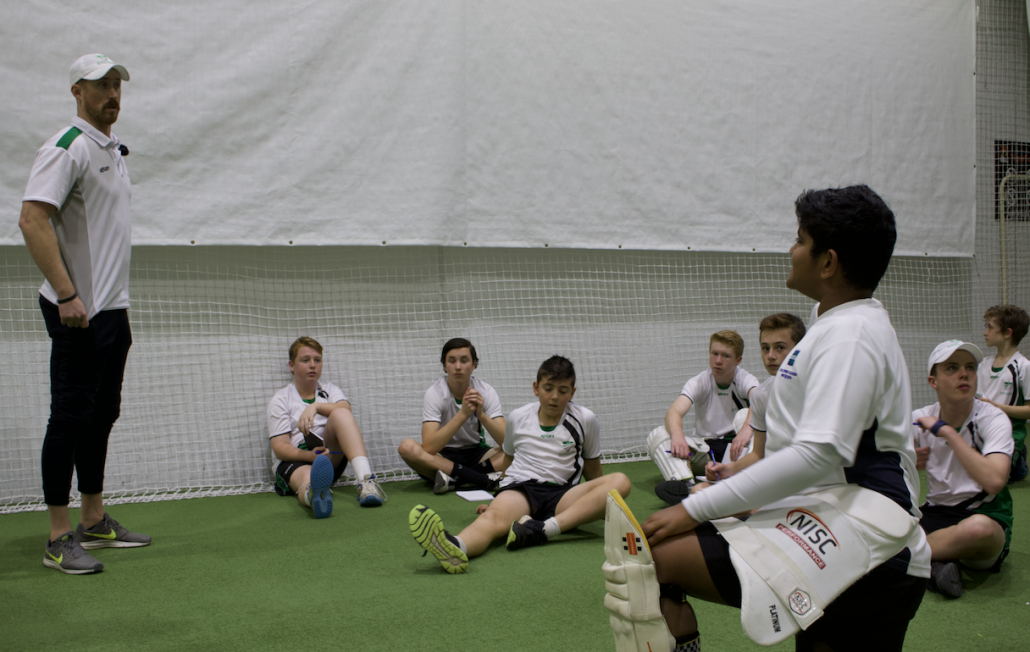In my opinion, creating a training environment that is as close as possible to the one we experience out in the middle is a critical contributor to the way a player performs but it’s something that’s largely overlooked.
I think it’s an area that cricket can improve dramatically (and is in the process of doing so), not just at junior level but senior level as well.
I’ve picked out 5 really common training behaviours that we see and I’ll explain why the create bad habits in a players game.

1. TOO MUCH WORK ON THE BOWLING MACHINE
This is is a big one…
It happens at team/group training sessions as well but I think a big contributor to this one is the huge influx we’ve seen in players just getting one-on-one coaching.
One-on-one’s are great for certain things and in limitation, but I think they’re very limited in the things you can do and they don’t allow a player to learn how to compete (that’s another story though.)
Let’s focus on bowling machines.
Some of the bad habits and negative effects of too much time on a bowling machine are…
- Moving before the ball is released.
Because you generally know where the ball is going to land you tend to start getting into position before the ball is released. Do this in a game and you’ll get yourself into big trouble.
- False sense of security.
Because you know where the ball is going to be and you’re moving early, you generally strike the ball well on a machine. This causes a false sense of security because it’s completely different to facing a bowler.
- Inability to read bowlers cues & slow reaction time.
The above mentioned causes an inability to pick up on bowlers cues - when they’re bowling short, when they’re bowling full, how they’re holding the ball. It also has a negative effect on your reaction time.
All that said, I’m not completely against using machines. They’re great for certain things…
Technical work and getting your shapes right on a certain shot.
But don’t over use them!
PRO TIP: If you’re not facing bowlers, use a side-arm. Far better for your reaction time and ability to pick up cues.
2. BOWLING WITHOUT MEASURING YOUR RUN-UP
I know sometimes circumstances don’t permit, but when possible all bowlers should be bowling off their full run-up - the same run up they use in a game.
Too many bowlers just run in from wherever at training or go off a ‘half run’.
I also believe every single fast bowler should measure their run-up with a tape measure.
How do you expect a stepped out run-up to be the same every single time? It’s simply impossible.
Garden tape measures are 25 bucks. If you want to improve your bowling consistency it’s a no brainer. Get yourself one.
Bowling off an inconsistent run up creates the following habits and problems…
- Lack of fluency.
There’s just no way you’re going to develop a smooth, fluent and consistent run-up if you’re training and playing with a different run-up all the time.
- Bowling no-balls.
This one is pretty obvious. Your strides are going to be different, you’re going to be taking off from different positions and that will contribute to the likelihood of you bowling no-balls.
PRO TIP: Buy a garden tape measure from Bunnings, measure your run-up to the millimetre and use it every time you bowl. Your run up will be more fluent, you will bowl less no-balls and it saves time in a match (measure both ends before the game starts).
3. BOWLING WITHOUT STUMPS & UMPIRE
The stumps and umpire act as a visual cue for when to start your take off and delivery stride.
If you don’t have at least stumps and better still an umpire (or something to imitate an umpire) you’re going to develop the bad habit of…
- Late entry into delivery stride.
This will lead to bowling more no-balls and then feeling like you have to hold back on your run-up in a match.
Have you ever felt like you’re steaming in at training and then feel like you’re bowling at 75% in a match?
PRO TIP: Use anything you can to imitate an umpire - chair, witches hat, agility pole with a hat on it, kit bag…anything is better than nothing!
PRO TIP TWO: If you are bowling noey’s in a game and feel like you have to hold back, ask the umpire to take a couple of steps back, this can help by giving you an earlier cue.
4. BATTING WITH NO FIELDERS
Obviously you can’t have fielders in the nets (if you can have centre wickets jump at it!).
But what’s the next best option?
Use cones, stumps, pool noodles, chairs…whatever you can to imitate fielders in the nets.
Two benefits….
Bowlers are thinking and getting into discussions about their fields (developing tactical & game awareness).
More importantly, it gives you, or the batsman a visual cue on where the fielders are and where the gaps are.
Now you have to actually think about where you’re hitting the ball which is completely different to hitting the ball anywhere.
Too many players hit the ball anywhere and everywhere in the nets without any accountability or thought of where the field is.
That causes an inability to hit gaps.
I don’t know how many times I’ve heard…”I feel so good in the nets, why can’t I score runs in the middle.”
That’s why.
At all of our Junior & Elite Youth Academy sessions we get bowlers to set fields with coloured cones in bat v ball sessions (infield and outfield colour).
PRO TIP: At the very least get your bowlers to set their fields verbally when you go in to bat. Then take a mental snap shot.

5. BATTING WITHOUT A PLAN OR PURPOSE
A bit of a follow on from #4.
A lot of batsmen walk into the net session with absolutely no plan or purpose around what they want to get out of the net session.
Are you practicing opening the batting?
Are you working on closing out an innings?
Do you want to practice ticking the scoreboard over like the middle overs of a one day game?
Not only your plans but the bowlers plans are going to be vastly different in those situations.
- Inability to develop plans.
If you go in and just ‘bat’ your ability to develop plans and react/adapt to different situations of the game is not going to be at an elite level.
Go to training with a clear plan on what you want to work on that session.
Make sure you let your bowlers know before or as you’re going into bat so they can also work on their plans. Win win.
- Lack of competitiveness.
Going in to just ‘bat’ is easy. There’s no pressure, there’s no competition.
Giving yourself scenarios is going to create pressure and teach you how to compete.
We want to develop competitive players.
PRO TIP: Be very clear on your role in the team and work on scenarios that you’re likely to find yourself in on a Saturday to create the “been there, done that” feeling when you go out to bat.
If you’re anything like me, a bowler that bats in the bottom 6, you’ll be practicing going in and doing the top 6’s job fairly regularly.
Haha jokes! Love the top 6 vs bottom 6 banter!
Anyway, I hope that’s helped!
Would love to hear which of those training behaviours you think you can apply to make a difference in your game.
Drop a comment in the box below or flick me an email on nick@australiancricketinstitute.com
Written by: Nick Fitzpatrick - ACI Co Founder & Coach


